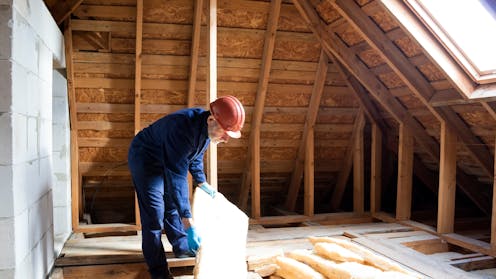The UK’s warm homes plan has been saved – here’s how Labour can learn from a decade of failed insulation schemes
The UK government confirmed in its June 2025 spending review that it will honour its manifesto pledge and not cut the £13.2 billion warm homes plan, as had been speculated. The money will be spent over the next four years, marking a significant increase on funding for energy-related home upgrades compared to that offered by the previous government.
The plan encompasses several programmes for cutting energy bills and reducing carbon emissions by making homes easier to heat and replacing gas boilers and other fossil fuel heating systems. Low-income homeowners and renters will receive grants for “retrofit” upgrades such as insulation, solar panels and heat pumps through schemes delivered by energy companies and councils.
All homeowners can benefit from the boiler upgrade scheme, which offers £7,500 towards the cost of a heat pump, and those living in the least energy efficient homes can get free loft or cavity wall insulation. Councils and housing associations will also receive funding to make upgrades to their properties.
The British government has provided some form of financial support for insulation and other energy efficiency measures since the 1970s. Millions of homes were insulated over the 2000s, but over the last decade support has been cut and the number of households taking up grants has collapsed. Programmes have also not been designed to provide comprehensive, high-quality retrofits.
Over the next few years, the warm homes plan will significantly increase the amount of funding available for retrofitting homes. This is an opportunity to reshape the UK’s strategy for fixing its cold, leaky housing stock, reduce reliance on gas heating and lower household energy bills.
How support for retrofitting has evolved
For the last 30 years, energy companies have been required to provide insulation and other energy efficiency measures to households. These programmes are funded by levies on energy bills rather than public spending.
From 1994 to 2015 any homeowner, landlord, or renter could receive energy efficiency measures such as insulation from energy companies. Additional publicly funded schemes sought to eliminate fuel poverty and targeted low-income households. This approach proved broadly successful throughout the 2000s and early 2010s. At its peak in 2008-11, one in five UK households received insulation, more efficient boilers or another form of support.
However, these schemes were never designed to provide the comprehensive retrofits that modern climate targets demand. Ultimately, they failed to take a whole-house approach that could address multiple energy-efficiency issues at once.
A pivotal moment came in 2015 when the Conservative-Liberal Democrat coalition government removed universal eligibility from supplier-led schemes and shaved £30 off annual household bills. Low-income and vulnerable households, which had already constituted a priority group under energy company-led schemes, became the only demographic eligible for support. Following this decision – plus other modifications to the programmes – the number of insulation measures installed each year fell by about 70%.
In 2023, the Conservative government of Rishi Sunak introduced the Great British insulation scheme which offers free cavity wall or loft insulation to homes registered given an efficiency rating of D or below (ratings run from A for the most efficient to G for the least). The universal boiler upgrade scheme was also introduced.
Meanwhile, the energy company obligation, which provides a greater range of measures, including several types of insulation, heat pumps and solar panels, remains restricted to low-income and vulnerable households.
However, due to complex eligibility requirements, low public awareness and a lack of trust, among other reasons, most of the financial support available is not reaching households and the number of homes receiving upgrades has not recovered.
Heat pumps can get homes off gas, but installations trail boiler fittings.
Martin Bergsma/Shutterstock
The problems with current schemes
While reinstating universal support is positive, the boiler upgrade scheme only covers about half the cost of installing a heat pump, making it a subsidy for wealthier households that can afford to foot the rest of the bill.
Energy bill levies, which fund the energy company obligation, disproportionately burden poorer households, which spend a higher proportion of income on energy. At the same time, while everyone continues to pay for the programme via their energy bills, restrictive eligibility requirements leave most households who cannot cover retrofit costs independently without support.
The scheme also incentivises companies and their subcontractors to meet the scheme’s carbon reduction requirements at the lowest possible cost. This discourages whole-house retrofits, more complex insulation measures, repairs prior to retrofit (such as removing damp and mould or repairing roofs) and work in certain types of homes.
Resulting insulation failures have damaged public confidence in retrofit programmes. These problems highlight the mismatch between a market-driven approach and the comprehensive changes necessary to make homes healthier to live in and cheaper to heat, as well as meet climate targets and restore public trust.
The case for replacing supplier-led schemes with public alternatives remains compelling, despite the government’s supposed fiscal constraints. Rather than relying on energy companies and their subcontractors for complex home interventions, councils could be empowered to guide households through the retrofit process and combine homes in area-based schemes.
The warm homes plan includes funding for councils to retrofit low-income households, including those earning less than £36,000, receiving means-tested benefits, or living in certain postcodes. But the scale of the programme is much smaller than the energy company obligation, although investment will increase over the next few years.
This is still a narrow approach to improve the country’s housing that focuses on low-income households, though most middle-income households cannot afford the cost of a retrofit either. The budget for other home improvements remains minimal – homes in poor condition are likely to be missed.
Details of how most of the warm homes plan funding will be spent is due to be revealed in autumn 2025. There is still time for the government to choose a more progressive approach.
An alternative would be to expand grant-funded upgrades for low-income homeowners and offer low-interest, long-term, property-linked loans for middle-income households. This could be designed to cover whole-house retrofits, encompassing insulation, ventilation, heat pumps, solar panels and other measures, as well as repairs.
There are also emerging plans from consultancies working with local governments to develop area-based retrofit programmes that blend public and private investment, aiming to attract investment from pension funds to shift the cost of retrofitting away from households.
However, it remains unclear whether such models will offer sufficiently competitive returns and low enough risk to appeal to institutional investors – and the UK cannot afford to wait for private capital to materialise when nationwide retrofitting is urgently needed.
Don’t have time to read about climate change as much as you’d like?
Get a weekly roundup in your inbox instead. Every Wednesday, The Conversation’s environment editor writes Imagine, a short email that goes a little deeper into just one climate issue. Join the 45,000+ readers who’ve subscribed so far.
Madeleine Pauker receives funding from the Energy Demand Research Centre, funded by the Engineering and Physical Sciences Research Council and the Economic and Social Research Council.




